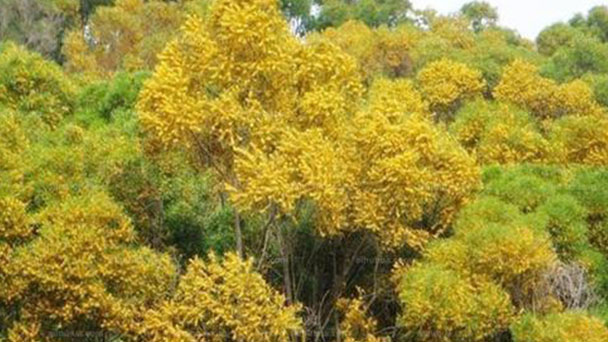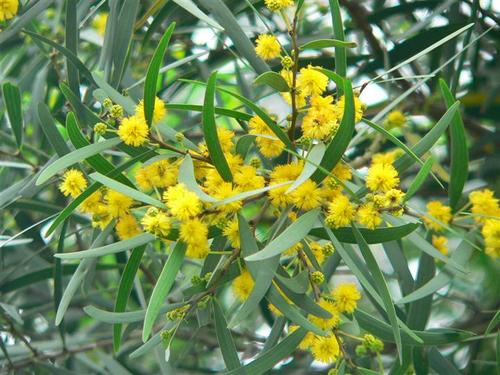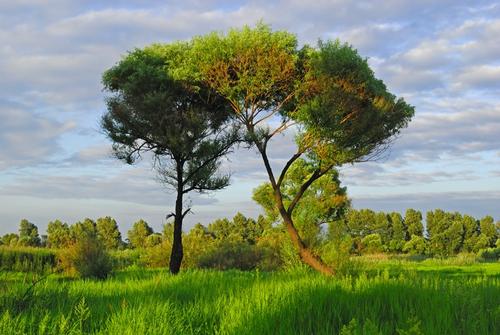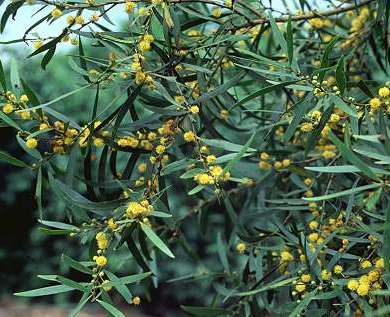Acacia Confusa profile
Written by Maggie
Sep 23 2021

Acacia Confusa branches are gray or brown, spiny, branchlets slender. At the seedling stage, the first true leaf is a pinnatifid compound leaf, and when it grows up, the leaflets become degenerated, and the petiole becomes leaflike petiole, which is leathery. Acacia Confusa is an important tree species for afforestation of barren hills, soil and water conservation and coastal shelterbelts in southern China. The material is hard and can be used for wheels, oars and farm tools. Bark contains tannin; Flowers contain aromatic oil, which can be used as a source of fragrance.
Acacia Confusa Picture

Acacia Confusa Morphological Characteristics
Acacia Confusa Branch
Acacia Confusa is an evergreen tree, 6 -- 15 m tall, glabrous; Branches are gray or brown, spiny, branchlets slender.
Acacia Confusa Leaf
The first true leaf of Acacia Confusa in the seedlings is pinnate compound leaves. When grown, leaflets become degenerate, petioles into leaf-shaped petioles, leathery, lanceolate, 6-10 cm long, 5-13 mm wide, straight or slightly curved falcate, tapering at both ends, slightly obtuse at the apex, glabrous on both sides, with 3-5 (-8) distinct longitudinal veins.
Acacia Confusa Flowers
Acacia Confusa is a globose head, solitary or in clusters of 2-3 in leaf axils, ca. 1 cm in diameter; Pedicels are delicate, 8 -- 10 mm long; The flowers are golden yellow and slightly fragrant; Calyx is about half as long as the corolla; Petals are pale green, ca. 2 mm; Stamens are numerous, clearly beyond corolla; Ovary is tawny pilose, style ca. 4 mm.
Acacia Confusa Fruit
The pods of acacia confusa are flattened, 4 -- 9 (12) cm long and 7 -- 10 mm wide, dark brown and lustrous when dry, slightly constricted between seeds, with a blunt and convex tip, base cuneate; Acacia Confusa has 2-8 sAcacia Confusa has 2-8 seeds, elliptic, compressed, 5-7 mm long.
Acacia Confusa Ecological Habits
Acacia Confusa grows near subtropical areas at low latitudes, mostly in coastal areas such as Lingnan and Taiwan Island in China. Acacia Confusa likes warm and hot climate, also low temperature, like light, also resistance to half shade, drought and poor soil, also resistance to short-term floodings, like acid soil.
The growth speed of Acacia Confusa is very fast and the adaptability is very strong. It can grow normally in a variety of environments. Acacia Confusa has strong nitrogen fixation characteristics, and the root has nodules, which can fix the nitrogen in the air and form nutrients. Long-term planting of the tree can also improve soil conditions. After the decomposition of these leaves, they form humus, which is the nutrient in the soil. After the decomposition of dead branches and leaves, the fertility of the soil will be increased, so its soil modification performance is particularly good.
Acacia Confusa Care
Acacia Confusa Soil Care
Although Acacia Confusa does not have high soil requirements, it is best grown in moist and loose slightly acidic, neutral or sandy loam soils below 350 m.In general, in the winter before afforestation to arrange the land. This will allow the soil to be fully weathered and more nutritious.
Acacia Confusa Fertilization Care
Acacia Confusa in the 10 days before planting to the foot base fertilizer, each hole 100 grams of hefei or 500 grams of phosphate fertilizer, about 83 plants per acre.
Acacia Confusa Temperature Care
Acacia Confusa is a fast-growing tropical evergreen tree, which requires high temperature and high humidity for growth. If it cannot meet its requirements, it will not be able to show its characteristics of rapid growth. So the general choice of afforestation in the rainy season, the best is in spring. Because temperatures are rising during this period, the recovery of Acacia Confusa seedlings after transplantation is very beneficial. Because of the rapid growth of the Acacia Confusa, it is usually closed to form a forest after one to two years.
Acacia Confusa Environment Care
Acacia Confusa likes light, but it is restricted by potting soil, so it can be shaded properly during potted landscape maintenance. Keep out of the summer glare.The ventilated environment is to ensure the respiration of plants, maintenance of the environment requires good ventilation. Under the condition of sunshine and ventilation, the basin soil can be dry, wet and orderly.
Acacia Confusa Watering
Acacia Confusa belongs to the southern deciduous species, prefer moist air. As bonsai maintenance, through the observation of the dry and wet state of the basin soil, to do "not dry not pouring is pouring through". Spray water once in the morning and once in the evening to hydrate the foliage and keep the surrounding air moist.
Acacia Confusa Pruning Care
In order to control the tree potential, control branches long, the first thing is to pick the budding heart, let branches germinate side buds, ensure a plump tree crown. In addition, in order to make branches reasonable and orderly, do not block each other sunlight, hinder ventilation. We should often trim the middle, long branches, cross branches, whorls, axillary branches and so on. In order to achieve peaceful tree potential, so that the branches of "sparse horse, airtight".
Acacia Confusa Nutrient Care
Acacia Confusa nutrient supply is mainly organic "nitrogen". Apply thin fertilizer every month in spring and fall. The use of retted cooked soybean cake fertilizer and livestock manure, directly applied to the basin soil can be. We can use slant additionally "phosphorus potassium" compound fertilizer. Soak water dilution, irrigation basin soil, supplement "phosphorus and potassium" fertilizer, promote root growth, improve crop disease resistance ability.

Acacia Confusa Disease control
Insect class
The main pests of Acacia Confusa are tea yellow thrips, large crickets, blowing cotton scale, longan ant boat moth and so on. Black grasshoppers, beetles, butterfly moths, leaf-a. Insects feed on branches and leaves; The black shopper lays its eggs in the shoot, causing the shoot to die.
Method of prevention and cure
① cut off the spawning branches of the burned black grasshopper.
② spray Acacia Confusa with 90% trichlorfon 800 times liquid.
Anthrax
It usually occurs between summer and autumn. Early seedling stem appeared on the size of the needle brown spots, after the expansion of the disease spots the whole Acacia Confusa dies. Prevention and control methods: ① burn the sick Acacia Confusa plant. (2) When the hair is in full bloom, spray 65% Dexin Zinc 600 times solution or Dexin Ammonium, Carbendazim and other liquid medicine for prevention and control.
Damping-off
Sick spots around the base of the Acacia Confusa seedlings and a circle of death.Can spray 1% Bordeaux liquid or 50% of the special 1000 times the liquid.
Spore fungus
Also known as Taiwan Acacia rust, grayish winter rust fungus: the disease began with light green, sometimes with red, after the gradual change to a brown or dirty brown. Victimized Acacia Confusa part is swollen, hypertrophic, if arching the small tumor of the shape of the disk, to one side rise, branch, leaf, fruit thus rolls up into deformity. The germ fruiting body of different development stages appears one after another on the small tumor, the light green granule is sperm organ, dark brown powdery is summer spore heap and gray-white villus is winter spore heap, the sick Acacia Confusa plant is weak, the growth is poor.
Method of prevention and cure
The infected leaves, shoot tips, and pod is burned before the new leaves are extracted. After the young Acacia Confusa leaves are extracted, the agent can be sprayed 2-3 times. The effective fungicides available are 1:1:100 Bordeaux liquid; Wave beauty 0.2-0.3 degree sulfur mixture;80% Dessen Zinc 600 times diluted;50% benzimidazole 500 times solution.
Acacia Confusa Distribution
Acacia Confusa is native to Taiwan, China, and can be found in plains, hills and low mountain areas throughout the island, as well as in the Philippines.
Acacia Confusa is cultivated in tropical and subtropical areas of Guangdong, Hainan, Guangxi, Fujian, Yunnan and Jiangxi provinces. It is distributed horizontally and grows normally in the south of 25°-26° N. Vertical distribution varies with latitude. In tropical areas of Hainan, it can be planted to an altitude of more than 800 meters, while in areas of higher latitude, it is generally only planted in the lowland below 200-300 meters.
Acacia Confusa Uses
The Acacia Confusa is hard and can be used for wheels, oras and farm tools. Bark containing tannin; Flowers contain aromatic oil, which can be used as a source of fragrance.
Acacia Confusa bark, fruit and other parts contain tannin, which can be used as a black dye; The stems can be used to burn charcoal. Its rapid growth, strong tillering ability, can resist typhoons, can be planted in the seaside, as a good soil and water conservation species. Wood is hard, wood can be used as pulpwood, wood-based panel, furniture, bark can be extracted tannin extract, leaves can be used as feed, economic and ecological benefits are very significant. Acacia Confusa wood is pink, beautiful, fine, straight and tough. It is a fine furniture material and can also be used for crafts and fine wood products. It is the main raw material for wood-based panels and fiberboards. It is the finest firewood.
Acacia Confusa's root differentiation is very much, can hold the soil tightly, coupled with the strong wind, drought and can grow in the advantages of the poor ridge, so commonly used for greening barren mountains, soil and water conservation.
The roots of the Acacia Confusa are fed by the nodule bacteria that fix nitrogen in the air and convert it into nitrogen that can be absorbed directly by the plant. Acacia Confusa can helps alleviate nitrogen deficiency in ridged-poor lands.

Latest Updated
- Benefits of Bugleweed - 7 Science-backed Health Benefits
- Bugleweed Dangers & Side Effects - Is It Poisonous?
- How to Plant Evergreen Trees - What You Should Know
- When to Plant Evergreens - Grow Guide for Evergreen Trees
- 12 Wonderful Evergreen Shrubs for Your Garden
- 12 Popular Evergreen Plants with Pictures for Beginners
- When And How To Prune A Lilac Bush Like a Pro
- How to Grow & Care for Lilac Vine (Hardenbergia Violacea)
- Japanese Lilac Tree (Syringa Reticulata) Care & Propagation Guide
- Shumard Oak Pros and Cons - What to Know
Popular Articles
- Winter maintenance of Antirrhinum Majus
- How to Grow Terminalia Mantaly Tree
- How to Grow and Care for Crossostephium Chinense
- How to grow Antirrhinum Majus in spring
- Peristeria Elata (Dove Orchid) Profile: Info & Care Guide
- Underwatered Snake Plant (Sansevieria Trifasciata) - Signs And How To Fix
- How to Care for Brazilian Jasmine Plant (Mandevilla Sanderi)
- How to Grow & Care for Graptopetalum Purple Delight in Summer
- Rosa Chinensis (China Rose): Plant Growing & Care Tips
- How to Care for Baby Sun Rose (Aptenia Cordifolia)